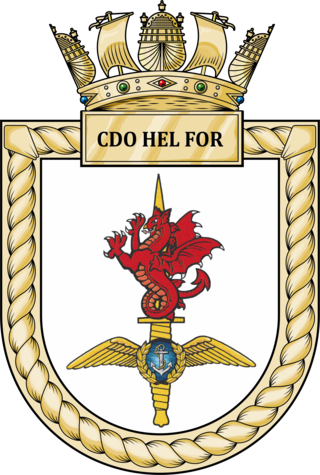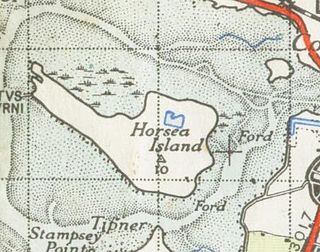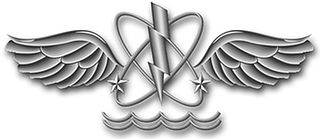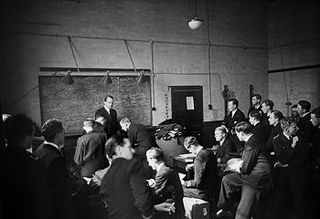
The Fleet Air Arm (FAA) is the naval aviation component of the United Kingdom's Royal Navy (RN). The FAA is one of five RN fighting arms. As of 2023 it is a predominantly "rotary" force, with helicopters undertaking roles once performed by biplanes such as the Fairey Swordfish. It operates the F-35 Lightning II for maritime strike and the AW159 Wildcat and AW101 Merlin for commando and anti-submarine warfare.

Royal Naval Air Station Yeovilton, commonly referred to as RNAS Yeovilton, is a military airbase of the Royal Navy, sited a few miles north of Yeovil, in the English county of Somerset. It is one of two active Fleet Air Arm bases, the other being RNAS Culdrose). RNAS Yeovilton is currently home to the Royal Navy Wildcat HMA2, along with Army Air Corps Wildcat AH1 helicopters, as well as the Royal Navy's Commando Helicopter Force Merlin HCi3/4/4A and Wildcat AH1 helicopters.

Commando Helicopter Force (CHF) is a unit of the Royal Navy Fleet Air Arm and an element of the Joint Helicopter Command of the British Armed Forces. Its primary role is to provide Rotary-Wing support to 3 Commando Brigade Royal Marines and other UK force elements in the amphibious environment. CHF uses a combination of transport helicopters based at Royal Naval Air Station Yeovilton in Somerset, England.

Horsea Island was an island located off the northern shore of Portsmouth Harbour, England; gradually subsumed by reclamation, it is now connected to the mainland. Horsea falls within the city of Portsmouth and was wholly owned by the Ministry of Defence as part of the shore establishment HMS Excellent, which maintains its headquarters on Whale Island.

The Davis Submerged Escape Apparatus, was an early type of oxygen rebreather invented in 1910 by Sir Robert Davis, head of Siebe Gorman and Co. Ltd., inspired by the earlier Fleuss system, and adopted by the Royal Navy after further development by Davis in 1927. While intended primarily as an emergency escape apparatus for submarine crews, it was soon also used for diving, being a handy shallow water diving apparatus with a thirty-minute endurance, and as an industrial breathing set.
The Helicopter Aircrew Breathing Device or HABD is an item of survival equipment which was adopted by the military to increase the chances of survival for embarked troops and aircrew trapped in an aircraft which has ditched. It is a form of self contained underwater breathing apparatus (scuba) which consists of a small cylinder pressurized with atmospheric air and first stage regulator worn in a pouch on the user's life vest; a pressure gauge; an air hose and a second-stage demand regulator that delivers air to the user's mouth when the internal pressure of the mouthpiece drops during inhalation, and is ruggedly constructed to survive impacts associated with emergency ditchings.

Aviation Survival Technician (AST) is a rating or job specialty in the United States Coast Guard. Rescue swimmer is the collateral duty or aircrew position of the AST. They are trained at the U.S. Coast Guard's enlisted Aviation Survival Technician/Rescue Swimmer school at Coast Guard Aviation Technical Training Center, Coast Guard Air Station Elizabeth City in Elizabeth City, North Carolina.

Naval Aircrewman (AW) is an enlisted general rating of the U.S. Navy. Sailors in the AW rating serve as aircraft systems operators or inflight system maintenance technicians aboard U. S. Navy fixed and rotoray winged aircraft. They perform duties as varied as aerial gunners, rescue swimmers, radar and sonar operators, airborne mine countermeasures system operators, strategic communications systems specialists, loadmasters, repair technicians, and various other functions depending on the specific aircraft type in which they fly. The rating is divided into five subdivisions termed "service ratings". Those service ratings are: Naval Aircrewman Operator (AWO); Naval Aircrewman Helicopter (AWS); Naval Aircrewman Tactical Helicopter (AWR); Naval Aircrewman Mechanical (AWF); and Naval Aircrewman Avionics (AWV). All five service ratings are identified by a single AW Rating Badge. Many technologically advanced navies have a similar trade.

HMS Vernon was a shore establishment or "stone frigate" of the Royal Navy in Portsmouth. Vernon was established on 26 April 1876, as the Royal Navy's Torpedo Branch also known as the Torpedo School, named after the ship HMS Vernon which served as part of its floating base. After the First World War, HMS Vernon moved ashore, taking over the Gunwharf site, where it continued to operate until 1 April 1996, when the various elements comprising the establishment were split up and moved to different commands.

A Submarine Escape Training Tower is a facility used for training submariners in methods of emergency escape from a disabled submarine underwater. It is a deep tank filled with water with at least one underwater entrance at depth simulating an airlock in a submarine. Since the 1930s, towers have been built for use by the Royal Navy, US Navy, Royal Australian Navy and in several other countries.

The Defence Survive, Evade, Resist, Extract (SERE) Training Organisation (DSTO), is a military training organisation based at RAF St Mawgan, Cornwall, in the United Kingdom. It is tri-service and trains personnel in survival techniques, evading capture and resistance from interrogation.

Underwater breathing apparatus is equipment which allows the user to breathe underwater. The three major categories of ambient pressure underwater breathing apparatus are:

760 Naval Air Squadron is a Naval Air Squadron of the Royal Navy's Fleet Air Arm. The squadron first formed in April 1940 as No.1 Fleet Fighter Pool with a variety of aircraft types before standardising in 1941 on the Hawker Sea Hurricane. In this role it disbanded in December 1942. In May 1944 760 NAS briefly reformed as an Anti-Submarine Operational Training Squadron before disbanding into 766 Naval Air Squadron in November. Reformed again as part of No.1 Naval Air Fighter School in April 1945 it converted fighter pilots to the Vought Corsair and then the Supermarine Seafire until 23 January 1946 when it disbanded.

The following outline is provided as an overview of and topical guide to underwater diving:

The following index is provided as an overview of and topical guide to underwater diving:
Diving support equipment is the equipment used to facilitate a diving operation. It is either not taken into the water during the dive, such as the gas panel and compressor, or is not integral to the actual diving, being there to make the dive easier or safer, such as a surface decompression chamber. Some equipment, like a diving stage, is not easily categorised as diving or support equipment, and may be considered as either.
Air 424 is the four-week survival training course that the Royal Navy gives to its pilots, whether helicopter or fixed-wing.
The Defence Diving School is a diver training centre in Hampshire, run by the Royal Navy.
Submarine rescue is the process of locating a sunk submarine with survivors on board, and bringing the survivors to safety. This may be done by recovering the vessel to the surface first, or by transferring the trapped personnel to a rescue bell or deep-submergence rescue vehicle to bring them to the surface. Submarine rescue may be done at pressures between ambient at depth, and sea level atmospheric pressure, depending on the condition of the distressed vessel and the equipment used for the rescue. Self-rescue of submarine personnel by buoyant free ascent at ambient pressure is considered submarine escape. Survivors may require recompression treatment for decompression illness.














